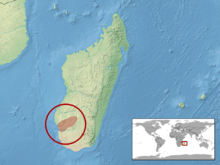Standing's day gecko
| Standing's day gecko | |
|---|---|
| | |
| Female of Phelsuma standingi, with prominent endolymphatic chalk sacs | |
| Conservation status | |
| Scientific classification | |
| Kingdom: | Animalia |
| Phylum: | Chordata |
| Class: | Reptilia |
| Order: | Squamata |
| Family: | Gekkonidae |
| Subfamily: | Gekkoninae |
| Genus: | Phelsuma |
| Species: | P. standingi |
| Binomial name | |
| Phelsuma standingi Methuen & Hewitt, 1913 | |
 | |
The Standing's day gecko (Phelsuma standingi) is an arboreal and diurnal species of gecko endemic to the Zombitse-Vohibasia National Park in the southwest of Madagascar.[1] It is among the largest living species of day geckos. Standing's day gecko feeds on insects and nectar.
Etymology
Its generic name is a Latinized version of the last name of Dutch physician Murk van Phelsum. Its specific name is in honor of another physician, Doctor Herbert F. Standing of Antananarivo, Madagascar. [2]
Description
This lizard is among the largest extant species of day geckos. It can reach a maximum length of 28 centimetres (11 in). The body colour can be quite variable, depending on light intensity. It can be brownish grey or bright green or turquoise with grey to blue reticulated markings on its body and head. The head and tail are often turquoise. Hatchlings have a yellowish green head and typical light bands and bars on their backs.
It is a sexually dimorphic species. In the males cloacal area has very pronounced preanal pores than the females and a bulge in the area of hemipenis. In many females two endolymphatic chalk sacs, located on the sides of their necks, are well-developed, while in males usually they are just barely visible. These sacs store calcium, which is needed for the formation of egg shells.
Distribution and habitat
Phelsuma standingi is restricted to the arid southwest of Madagascar, specifically the region around Andranolaho and Sakaraha. This area has a unique thorn forest vegetation. The daytime temperature never drops under 20 °C (68 °F) and between January and December, the temperature can be as high as 40 °C (104 °F) in the shade. In July and August, the night temperature can drop to 13 °C (55 °F).
Diet
Standing's day gecko feeds on various insects, invertebrates, and even smaller lizards. It is omnivorous however, supplementing its prey with soft, sweet fruit, pollen and nectar.
Behaviour
This strictly arboreal species lives in pairs on trees; these geckos spend a lot of time basking in the sun on the highest and well exposed branches. The males are very territorial and will fight when in presence of other males; females have this character towards other females, this behavior is rather rare in geckos.
Reproduction
At a temperature of 28 °C (82 °F), the young will hatch after approximately 60–70 days. The juveniles measure 80 mm and reach sexual maturity after one year.
Care and maintenance in captivity
These animals should be housed in pairs and need a large, planted terrarium. The daytime temperature should be around 30 °C (86 °F). A spot lamp should provide the animals with a basking spot and a local temperature of 35 °C (95 °F). At night, the temperature should be dropped to 22 °C (72 °F). In captivity, these animals can be fed with a variety of insects and insect larvae (e.g. crickets, young roaches, wax moth larvae, mealworms, and houseflies); to substitute the natural nectar, fruit puree can be offered; vitamin and calcium supplements are necessary for a healthy development of this lizard.
Original text
- Methuen & Hewitt, 1913 : On a collection of reptiles from Madagascar made during the year 1911. Annals of the Transvaal Museum, vol.3, n.4, p. 183-193 (Full text).
References
- ↑ "Zombitse Vohibasia". http://www.parcs-madagascar.com/''. Madagascar National Parks. Retrieved 9 September 2014.
- ↑ Beolens, B.; Watkins, M.; Grayson, M. (2011). The Eponym Dictionary of Reptiles. The Johns Hopkins University Press. p. 251. ISBN 978-1-4214-0135-5.
- Madagascar Reptile & Amphibian Specialist Group (1996). Phelsuma standingi. 2006. IUCN Red List of Threatened Species. IUCN 2006. www.iucnredlist.org. Retrieved on 11 May 2006. Listed as Vulnerable (VU A1cd v2.3)
- Henkel, F.-W. and W. Schmidt (1995) Amphibien und Reptilien Madagaskars, der Maskarenen, Seychellen und Komoren. Ulmer Stuttgart. ISBN 3-8001-7323-9
- McKeown, Sean (1993) The general care and maintenance of day geckos. Advanced Vivarium Systems, Lakeside CA.
External links
| Wikispecies has information related to: Standing's day gecko |
| Wikimedia Commons has media related to Standing's day gecko. |
